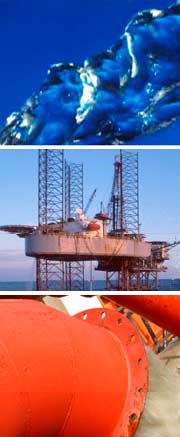 |

 Kelly Hurt, Hamid Borazjani, Susan Diehl & Mary Hannigan Kelly Hurt, Hamid Borazjani, Susan Diehl & Mary Hannigan
Objective:
To evaluate the effectiveness of forced air injection, addition of Kengro Biosorb, and application of a fungus in enhancing creosote biodegradation and to determine if biopiling could be considered for future remediation at similar sites.
|
PAH HALF-LIVES
|
| Control |
313 days
|
| Vented |
404 days |
| Kengro Biosorb |
249 days |
| Fungi |
252 days |
Overview:
Bioremediation has been successfully employed at many sites contaminated with wood-preserving waste and is favored for its cost-effectiveness. However, physical and biological parameters can limit its potential. Landfarming can enhance biodegradation by increasing the oxygen content and friability of the soil. Spatial restrictions at some sites make landfarming operations impractical. Biopiling is the injection of air into piles of contaminated soil, thus enhancing the aerobic breakdown of contaminants by increasing oxygen levels.
Experimental Plan:
A year-long biopiling study was conducted at a closed wood-treating facility in south Mississippi.Twelve piles of 4 m long x 3 m wide x 1 m high were constructed in three randomized complete blocks of four treatments with three replicates per treatment.Treatments were controls, vented, vented plus 1% Kengro Biosorb, and vented with 1% Kengro Biosorb plus Cladosporium fungus. Control piles lacked additives or vent pipes.Vented piles were constructed with five perforated plastic pipes for air injection.Air was supplied by an electric blower that ran continuously for the study period. Seventeen of creosote’s polycyclic aromatic hydrocarbons (PAHs) were monitored at 45-day intervals.
Conclusions:
- Forced air injection proved to be an inadequate technique for enhancing biodegradation of this type of soil
- The concentrations of PAHs in the control treatment were equal to or less than levels found in the other treatments at day 360.
- Initial excavation and mixing aerated the soil and was responsible for the rapid degradation rates prior to day 90.
- Low bioavailability and nutrient deficiency may have been responsible for the lack of degradation after day 90.
- Biopiling would be better suited for higher permeability soils than the heavy clay soil present in this study.

|
|